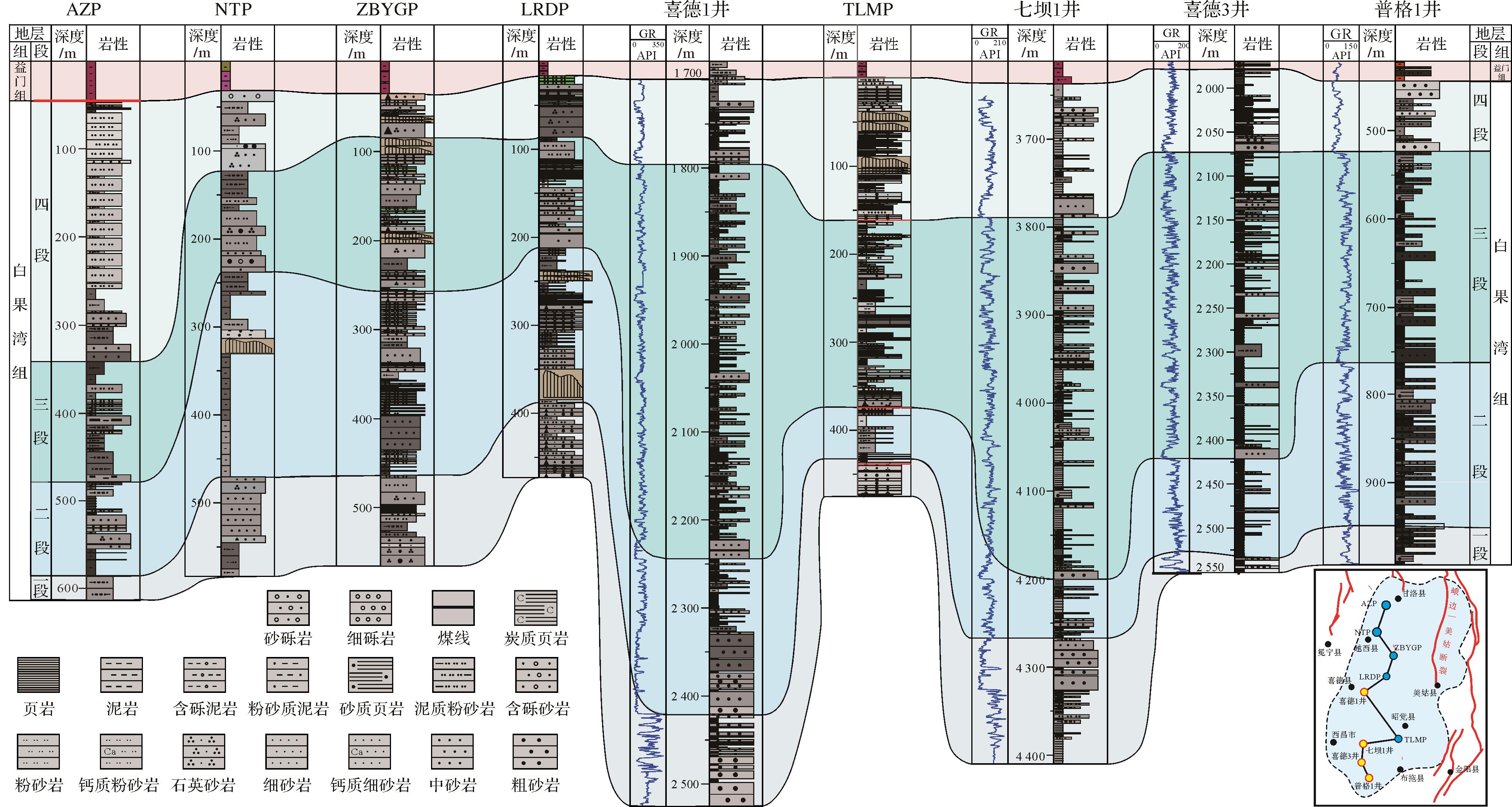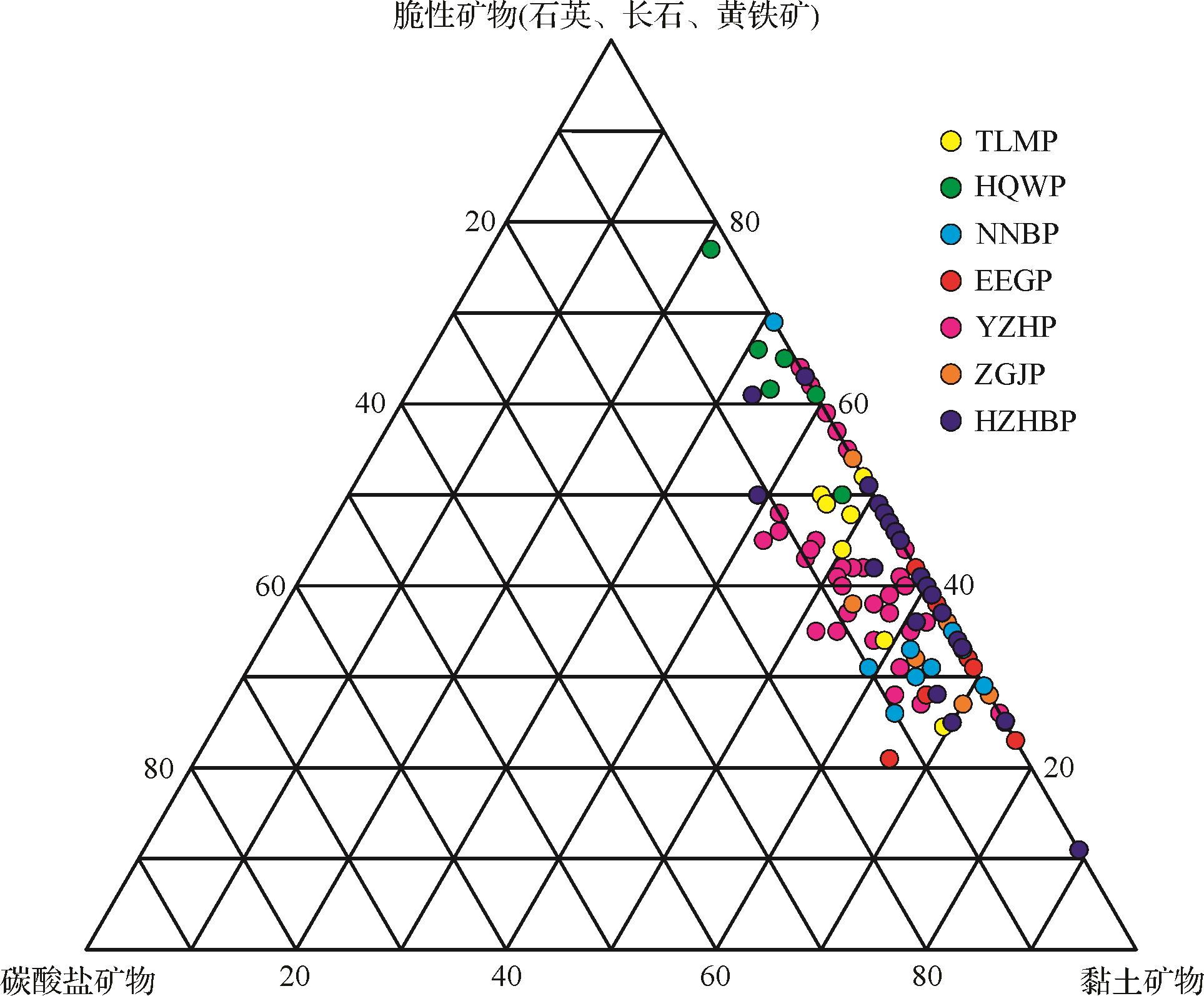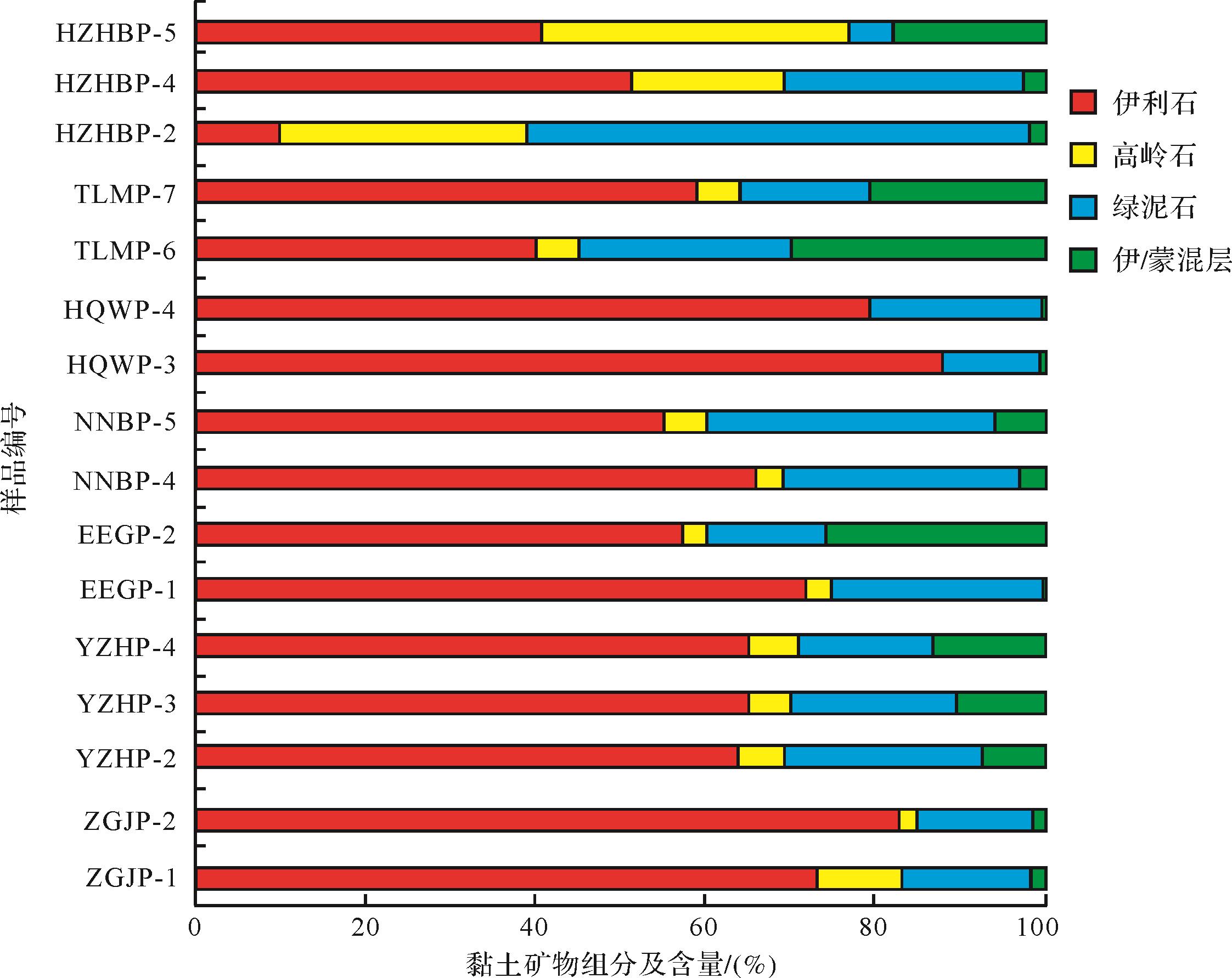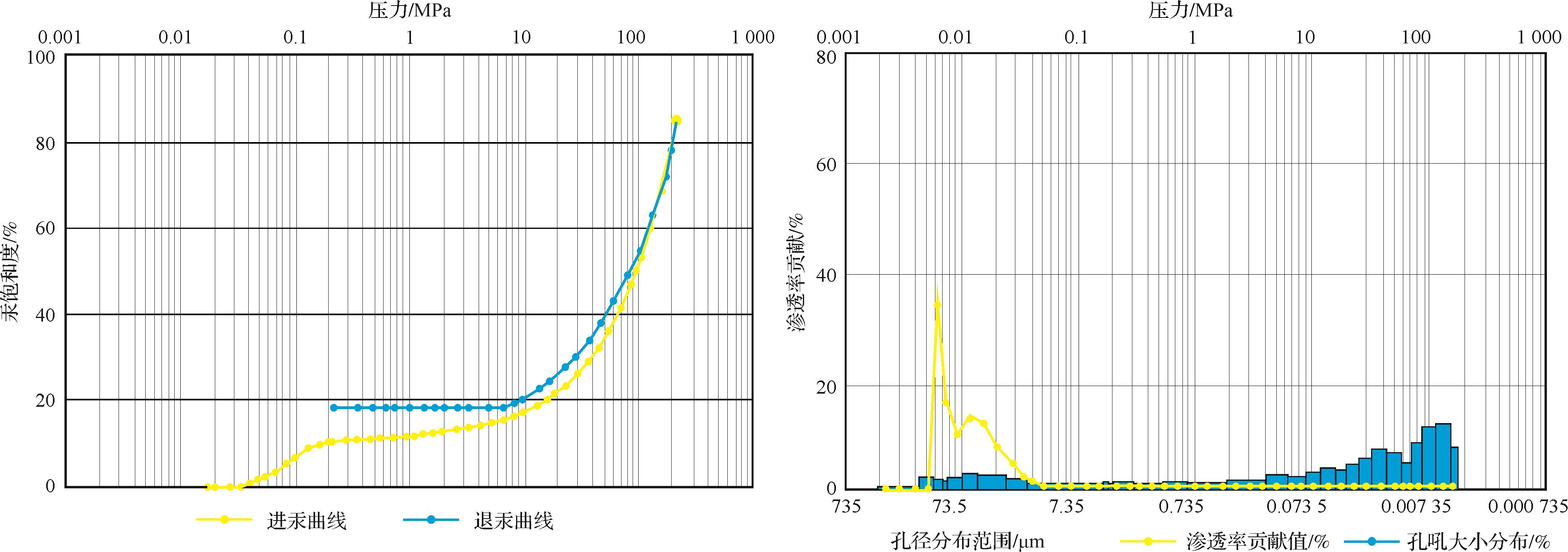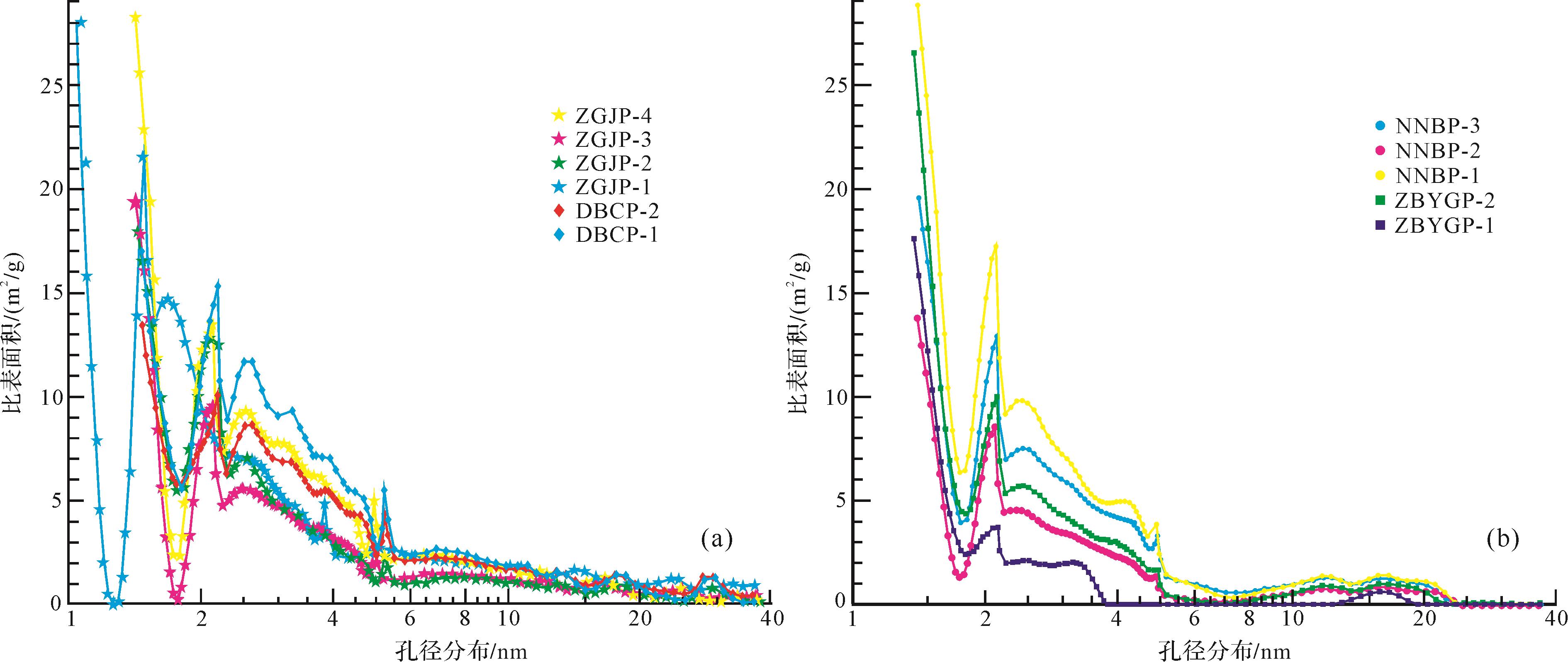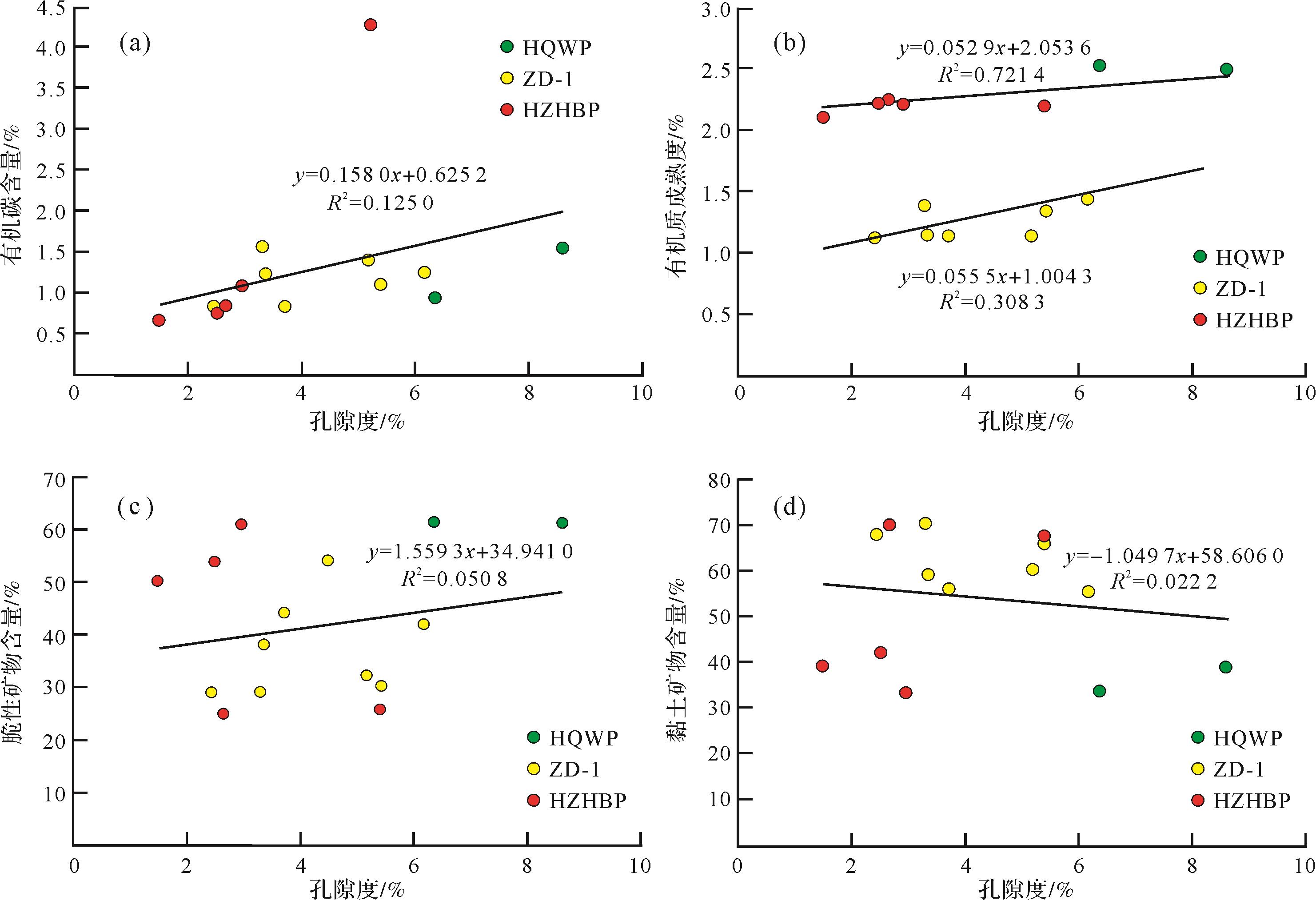HTML
-
美国页岩气勘探开发取得的重大成果,对当今国际能源形势产生十分巨大影响[1⁃2]。受多旋回的构造演化影响,国内沉积盆地发育了海相、海陆过渡相以及陆相3类富有机质泥页岩层系[3⁃5],随着海相富有机质泥页岩在涪陵焦石坝、长宁、威远等区块取得重要突破[6],海陆过渡相泥页岩的研究也备受关注[7⁃10]。四川盆地东北部元坝区块下侏罗统大安寨段6井已获得工业性页岩气流,最高日产量达50.7×104 m3/d[11],川西坳陷上三叠统须家河组川合100井、川合137井、川合138井,获得工业页岩气流,最高日产量达20×104 m3/d[12],新页HF-2井日产1.2×104 m3/d[13];延长区块在延页平3井、柳坪171井、新57井均获得了日产量大于2 000 m3的工业气流[14⁃16];渤海湾盆地新港57井日产13.7×104 m3/d[17],可见海陆过渡相泥页岩具有较大勘探潜力。
目前国内学者已对西昌盆地上三叠统白果湾组泥页岩沉积相[18⁃19]、孔隙特征[20]、保存条件[21]等方面做了一定研究,但针对白果湾组泥页岩储层特征的研究较少。泥页岩储层特征是影响页岩气聚集成藏的主要因素[22],因此对泥页岩储层特征的研究十分必要。本文以西昌盆地上三叠统白果湾组泥页岩为研究对象,通过26个野外剖面实测、242件样品的分析,结合泥页岩的岩性特征和厚度对比,开展铸体薄片观察、有机地化分析、全岩X射线衍射分析、孔隙度和渗透率分析、扫描电镜、高压压汞、低温N2吸附等实验,综合分析西昌盆地上三叠统富有机质泥页岩储层特征及主控因素,以期指导西昌盆地页岩气的勘探开发。
-
西昌盆地为南北向展布的狭长构造盆地,位于扬子准地台西侧,横跨康滇台隆和川滇鄂台坳两个二级构造单元[23]。盆地的区域地质背景以及区域构造演化与邻区四川盆地西部具有较大的相似性[24],从构造演化上看,研究区在中新生代经历了两大发展阶段,即早—中三叠世的拉张阶段以及晚三叠世至今的挤压阶段,前者处于东西向拉张的构造环境,后者经历了东西向挤压及北西一南东向挤压的不同作用[25],盆地的局部构造大多是在燕山期—喜山期形成的[26]。西昌盆地东部以峨边断裂为界,西部以安宁河断裂为界,南部以则木河断裂为界,向部北延伸至大渡河附近[25]。盆地内断裂均呈南北向分布,自西向东依次发育安宁河—则木河断裂、黑水河断裂、石棉—昭觉断裂、汉源—甘洛断裂、峨边—美姑断裂,受构造演化的影响西昌盆地内发育甘洛凹陷、米市凹陷、麻姑山凹陷、美姑凹陷以及昭觉凹陷等5个次级构造单元(图1a)。

Figure 1. Sample collection points and comprehensive histogram of the Upper Triassic Baiguowan Formation in the study area
西昌盆地上三叠统白果湾组自下而上可分为四段,结合岩性及沉积构造特征可识别河流相、三角洲相以及湖泊相三种沉积相。富有机质泥页岩主要发育在白果湾组二段,岩性主要为深灰色—灰黑色薄中层状泥岩、灰黑色中层状粉砂质泥岩间夹深灰色薄层状粉砂岩,层面见植物化石,发育水平层理及波状交错层理,为浅湖亚相沉积[20](图1b)。
-
系统采集西昌盆地26个野外露头剖面以及1口地质调查井上三叠统白果湾组富有机质泥页岩242件样品。有机地化实验:1)有机碳含量(TOC),依据标准GB/T 19145—2003《沉积岩中有机碳的测定》,采用CS-400碳硫测定仪进行测试分析;2)有机质类型,依据标准SY/T 5125—2014《透射光—荧光干酪根显微组分鉴定及类型划分方法》,采用偏光显微镜Axio Scope.A1进行测试分析;3)有机质成熟度(Ro),依据标准SY/T 5124—2012《沉积岩中镜质体反射率的测定方法》,采用偏光显微镜Axio Scope.A1、JM分光光度计MSP400进行测试分析。岩石学实验:X衍射矿物组分,依据标准SY/T 5163—2010《沉积岩中的黏土矿物和常见非黏土矿物X射线衍射分析方法》,采用荷兰帕纳科X'Pert Powder进行测试分析。物性试验:1)孔隙度,依据标准GB/T 5336—2006《岩心分析方法》,采用HKXD-V型氦孔隙度自动测定仪进行测试分析;2)渗透率,依据标准GB/T 5336—2006《岩心分析方法》,采用YCS-Ⅱ型煤和岩石渗透率测试仪进行测试分析;3)微观孔隙类型,依据标准SY/T 5162—2014 《岩石样品扫描电子显微镜分析方法》,采用ZEISS sigma300场发射扫描电镜进行分析测试;4)压汞实验,依据标准GB/T 21650.1—2008/ISO 15901-1:2005《压汞法和气体吸附法测定固体材料孔径分布和孔隙度》,采用麦克AUTOPORE 9500进行分析测试;5)低温氮气吸附脱附实验,依据标准SY/T 6154—1995《岩石比表面和孔径分布测定静态氮吸附容量法》,采用麦克MICROACTIVE FOR ASAP 2460进行分析测试。
-
研究区内上三叠统白果湾组分布广泛,受构造演化的影响沉积厚度变化较大。结合钻井以及野外实测剖面统计,泥页岩厚度主要集中在20~110 m,沉积中心位于喜德1井—喜德3井—七坝1井附近,厚度在110 m左右。自沉积中心向东、向北泥页岩厚度均逐渐降低,向东至特洛莫剖面附近泥页岩厚度降至78 m,自沉积中心向北至乃拖附近泥页岩厚度降至82 m,至阿寨附近泥页岩厚度降至30 m(图2)。

Figure 2. Stratum thickness correlation diagram of the Upper Triassic Baiguowan Formation in the study area[18]
-
富有机质泥页岩有机质类型、有机质丰度、有机质成熟度是控制页岩气聚集、成藏的主要因素[2],为了直观地认识研究区上三叠统白果湾组富有机质泥页岩基础地质条件,通过样品采集进行实验分析(表1)。
样品编号 显微组分含量/% 干酪根数(TI) 干酪根类型 TOC/% Ro/% 腐泥组 壳质组 镜质组 惰质组 NNBP 0 69~77 73.0 17~24 20.50 6~7 6.50 9.5~19.8 14.65 Ⅱ2 0.68~1.03 0.86 2.96~2.97 2.97 TLMP 0 55~63 57.5 29~35 32.75 8~18 11.75 -9.5~-1.8- 5.55 Ⅱ2/Ⅲ 1.11~-1.64 1.35 1.82~2.13 2.02 AEP 0 52~58 55.5 29~37 33.75 7~14 10.75 -13.5~-4.3- 8.35 Ⅲ 0.59~1.4 0.99 1.69~2.41 1.99 EEGP 0 63~71 65.5 24~29 26.75 5~10 7.75 1.3~12.5 4.96 Ⅱ2 1.13~1.54 1.41 1.02~1.55 1.22 TDP 0 62~70 65.5 25~31 28.00 5~7 6.00 0.8~11.3 6.05 Ⅱ2 1.02~1.13 1.08 1.05~1.10 1.08 YMPM 0 82~89 85.5 5~9 7.00 6~9 7.50 25.3~-34.8 30.05 Ⅱ2 0.76~1.01 0.89 3.85~3.87 3.86 YGP 0 72~75 74.0 18~20 19.00 6~8 7.00 13.0~17.3 15.77 Ⅱ2 0.41~1.28 0.91 1.14~1.75 1.41 HQWP 0~20 6.7 69~89 80.0 1~3 1.30 10~15 12.00 23.8~43.8 34.00 Ⅱ2 0.33~2.09 1.03 2.49~2.70 2.61 HZHBP 0 49~59 53.6 29~40 35.20 9~14 11.20 -17~-4.4- 10.86 Ⅲ 0.3~2.21 0.92 1.36~2.42 1.88 注: 73为平均值。 -
研究区上三叠统白果湾组富有机质泥页岩样品镜检分析显示,干酪根显微组分以壳质组为主,含量介于49%~89%,平均为63.8%,其次为镜质组,含量介于1%~40%,平均为26.1%,惰质组含量较少,为5%~18%,平均为9.5%,腐泥组含量最少,为0~20%,平均为0.6%,干酪根类型指数(TI)介于-17~43.8,平均为3.5,有机质类型主要为Ⅱ2型和Ⅲ型(表1)。
-
有机碳既是页岩吸附气的主要载体,又是页岩生烃量的重要因素,直接影响着页岩吸附气的含量以及生烃强度[27]。国内部分学者将泥页岩有机碳含量下限值定为1.0%[28⁃30]。西昌盆地上三叠统白果湾组富有机质泥页岩有机碳含量介于0.3%~2.21%,平均为1.02%(表1),高于泥页岩TOC评价指标(1.0%),具有较好的勘探潜力。
-
研究区内上三叠统白果湾组富有机质泥页岩有机质成熟度(Ro)分布不均,喜德、美姑地区Ro值较高,为2.96%~3.87%,已达到过成熟晚期阶段;越西地区Ro值介于1.69%~2.41%,平均为2.01%,有机质处于成熟阶段—过成熟阶段;昭觉一带Ro值相对较低,为1.02%~2.16%(表1),处于未成熟到过成熟早期阶段。
4.1. 有机质类型
4.2. 有机质丰度
4.3. 有机质成熟度
-
研究区上三叠统白果湾组富有机质泥页岩矿物组分较为复杂,以石英、黏土矿物为主,含少量长石、方解石、白云石、黄铁矿,矿物组分存在较大差异,北部甘洛地区石英含量较高介于50%~71%,平均为63.57%,黏土矿物含量介于21%~47%,平均为34.33%,碳酸盐矿物(方解石、白云石)含量较少,为0~4%,平均为2.1%;中部喜德—美姑一带石英含量介于28%~69%,平均为37.8%,黏土矿物含量较高,介于31%~74%,平均为58.3%,碳酸盐矿物(方解石、白云石)含量较低,为0~31%,平均为2.8%;南部布拖一带,石英含量介于11%~63%,平均为40.79%,黏土矿物含量介于33%~89%,平均为56.91%,碳酸盐矿物含量较低,为0~11%,平均为2.3%(图3),研究区内脆性矿物含量均大于40%,有利于页岩气的压裂。

Figure 3. Triangle diagram of mineral components in organic⁃rich shale of the Upper Triassic Baiguowan Formation in the study area
富有机质泥页岩黏土矿物主要为伊利石、高岭石、绿泥石、伊/蒙混层,其中,伊利石含量介于10%~88%,平均为60.2%,高岭石含量介于0~36%,平均为8.1%,绿泥石含量介于5%~59%,平均为21.9%,伊/蒙混层含量介于0~30%,平均为9.8%(图4)。
-
研究区上三叠统白果湾组富有机质泥页岩孔隙度在1.28%~9.02%之间,平均为4.03%,其中小于2%的占14.4%,孔隙度介于2%~4%的占42.8%,孔隙度介于4%~6%的占28.6%,介于6%~8%的占7.1%,介于8%~10%的占7.1%。渗透率变化较大,为(0.001 7~0.146)×10-3 μm2,平均为0.03×10-3 μm2,其中,渗透率介于(0.001~0.01)×10-3 μm2的占80%,渗透率介于(0.01~0.1)×10-3 μm2的占10%,渗透率介于(0.1~1)×10-3 μm2的占10%,渗透率大于1×10-3 μm2的无。富有机质泥页岩孔隙度与渗透率具有一定的正相关性,渗透率随孔隙度的增大而增大。
-
运用扫描电镜识别出西昌盆地上三叠统白果湾组富有机质泥页岩发育粒间孔、粒内孔、有机质孔三种孔隙类型。
(1) 粒间孔
粒间孔主要包括矿物颗粒与矿物颗粒粒间孔(图5a)、矿物颗粒与片状黏土矿物粒缘孔缝(图5b)、片状黏土矿物与片状黏土矿物层间缝(图5c)。由于矿物颗粒与片状黏土矿物大小不一、形态各异,导致粒间孔孔径分布范围较广,粒间孔孔径介于0.1~5 μm,粒间孔连通性较好,既可作为页岩气的运移通道又可作为页岩气的储集空间。

Figure 5. SEM image of intergranular pore in organic⁃rich shale of the Upper Triassic Baiguowan Formation in the study area
(2) 粒内孔
粒内孔是黑色泥岩矿物颗粒内发育的孔隙,以溶蚀孔为主,且种类较多,常见于碳酸盐岩颗粒溶蚀孔(图6a)、钠长石颗粒溶蚀孔(图6b)、黄铁矿晶粒溶蚀后形成的铸模孔(图6c),溶蚀孔孔径分布范围主要为0.1~6 μm,连通性较好。

Figure 6. SEM image of intergranular pore in organic⁃rich shale in the Upper Triassic Baiguowan Formation in the study area
(3) 有机质孔
有机质孔是有机质在生烃过程中形成的孔隙,不同区域,甚至同一颗有机质的不同部位发育的有机质孔,在数量、孔径、形态等方面存在巨大差异[31]。西昌盆地上三叠统白果湾组富有机质泥页岩有机质孔孔径分布不均,形态各异,孔径主要为0.2~5 μm,部分孔壁较为圆滑,在昭觉一带有机质孔发育较好,且具有较好的连通性,在ZGJP剖面附近富有机质泥页岩有机质孔发育较差,有机质孔零星分布(图7c)。
-
微裂缝即可作为页岩气的运移通道又可作为页岩气的储集空间[31⁃32]。研究区上三叠统白果湾组富有机质泥页岩中微裂缝较为发育,充填物主要为方解石、石英,部分微裂缝中充填少量有机质,缝宽主要为0.01~0.1 mm(图8),可作为页岩气良好的储集空间。
-
富有机质泥页岩的微观孔隙结构对页岩气储存状态及储气性能有着直接影响[33⁃34]。纳米级孔喉是富有机质泥页岩的主要孔喉类型,所占比例超过总孔喉数量的85%[35],孔喉直径主要为0.005~0.1 μm[8],富有机质泥页岩孔径极其微小,利用高压压汞法不易将汞压入富有机质泥页岩的微孔[36],且容易因压力过高造成人为微裂隙,对实验结果造成较大影响[37⁃38],可利用低温液氮分析法测定富有机质泥页岩孔径小于100 nm的孔隙。与压汞实验相比,低温液氮吸附实验不存在高压下孔隙结构发生压缩、变形和破裂所导致的误差,能精确地表征纳米级孔隙结构特征[39]。本文同时运用高压压汞法和低温N2吸附法,分析研究区上三叠统白果湾组富有机质泥页岩孔径分布特征,按文献[40]的划分方案,把1~10 nm认定为微孔、10~100 nm认定为小孔、100~1 000 nm认定为中孔、大于1 000 nm认定为大孔。
-
研究区上三叠统白果湾组富有机质泥页岩孔径分布范围较广,且不同区域内分布不一,孔隙具双峰分布特点。当进汞压力介于0.01~0.1 MPa时,进汞饱和度随压力的增加而增加,表明微米级大孔隙发育较好;当进汞压力在0.1~10 MPa时,进汞量变化较小,表明50~1 000 nm的大孔发育较差;当进汞压力在10~100 MPa时,进汞量大量增加,表明中孔发育较好。退汞率达78.14%,表明孔吼连通性较好(图9)。
-
研究区上三叠统白果湾组富有机质泥页岩比表面积(BET法)介于6.25~13.7 m2/g,平均为10.17 m2/g;总孔体积分布(BJH法)介于0.013~0.029 cm3/g,平均为0.02 cm3/g;平均孔径(BET法)介于6.66~9.79 nm,平均为8.24 nm(表2)。
剖面名称 样品编号 BET孔隙比表面积/(m2/g) BJH孔隙比孔容/(cm3/g) BET孔隙直径/nm NNBP NNBP-4 10.62 0.025 9.41 NNBP-3 7.17 0.016 8.75 NNBP-2 13.69 0.030 8.57 ZBYGP ZBYGP-4 12.93 0.020 7.21 ZBYGP-3 8.34 0.020 8.46 ZGJP ZGJP-4 10.07 0.022 8.44 ZGJP-3 6.25 0.016 9.79 ZGJP-2 8.30 0.013 6.97 ZGJP-1 13.70 0.021 6.66 DBCP DBCP-3 9.04 0.019 8.56 DBCP-2 11.78 0.023 7.83 孔隙的比表面积在1.48~20 nm的孔径范围内具双峰、三峰分布特征,峰值主要出现在1.48~6 nm,少量出现在10~20 nm,结合比表面积随孔径的分布规律可以看出,孔隙以1.48~6 nm的微孔为主,10~20 nm之间的小孔次之(图10),泥页岩的微孔具有较强的自封闭能力,且其封闭能力受构造作用的影响较小[41⁃43]。研究区内上三叠统白果湾组富有机质泥页岩具有良好的页岩气储集空间。
-
富有机质泥页岩储层特征主要受沉积环境、有机碳含量、有机质成熟度、矿物组分等因素影响[44⁃48],本文主要从沉积环境以及有机碳含量、有机质成熟度、脆性矿物含量、黏土矿物含量对孔隙度大小的影响进行探讨。
-
沉积环境为储层提供物质基础,直接影响着储层的基础地质条件,不同的沉积环境下沉积的富有机质泥页岩有所差异,古气候、古水深以及沉积相类型等直接影响其发育特征[49]。西昌盆地上三叠统富有机质泥页岩主要发育在白果湾组二段(图11a),层面见大量植物叶片化石(图11b),偶见零星分布的黄铁矿(图11c),有机碳含量普遍大于1%,为浅湖亚相沉积。
-
(1) 有机碳含量对物性的影响
有机碳含量既是烃源岩生烃的主要因素之一,也直接控制着有机质孔的发育[50⁃51]。有机质孔以微米—纳米级孔隙为主,可为页岩气的聚集提供良好储集空间。研究区上三叠统白果湾组富有机质泥页岩孔隙比表面积、有机碳含量,与孔隙体积和有机碳含量均具有良好的正相关性(图12)。孔隙度与有机碳含量呈正相关性(图13a),表明有机碳含量是富有机质泥页岩孔隙度大小的重要控制因素。

Figure 12. Relationships between organic carbon content and pore specific surface area and pore volume

Figure 13. Relationships between porosity and organic carbon content, maturity, brittle mineral content and clay mineral content
(2) 有机质成熟度对物性的影响
Woodford页岩样品有机质孔在液态窗阶段较少,进入气态窗后有机质孔数量快速增加[52]。通过对北美Barnett盆地页岩样品有机质成熟度进行模拟可知,当有机质成熟度由0.55%增至1.4%时,泥页岩样品因有机质分解产生4.3%的孔隙体积[53],但有机质孔并非一直随着成熟度的增加而增加,当有机质成熟度达到一定界限值后,有机质孔出现减少的情况[52]。焦石坝地区富有机质泥页岩有机质成熟度为2.2%~3.13%,处于有机孔隙生成的最佳阶段[49]。研究区大部分区域富有机质泥页岩有机质演化程度较高,处于成熟—过成熟晚期阶段,孔隙度与有机质成熟度之间具有微弱的正相关性,而在昭觉一带富有机质泥页岩有机质成熟度介于1.0%~1.5%,孔隙度与有机质成熟度具有较好的正相关性(图13b),表明有机质在生烃过程中形成了部分有机质孔,在一定程度上提高了富有机质泥页岩的孔隙度。
(3) 脆性矿物含量对储层物性的影响
脆性矿物的含量对富有机质泥页岩孔隙的发育以及后期储层压裂改造有重要的影响[54⁃55]。研究区上三叠统富有机质泥页岩脆性矿物含量与孔隙度之间呈微弱的正相关性(图13c),表明脆性矿物含量的增加在一定程度上可以适当增强富有机质泥页岩的抗压实能力,有利于富有机质泥页岩中孔隙的保存[56]。
(4) 黏土矿物含量对储层物性的影响
黏土矿物在脱水转化过程中产出大量层间水,形成黏土矿物层间孔、缝,同时伊利石转化过程中同样会产生大量微孔隙[57](不规则片状黏土矿物层间缝、粒缘孔缝以及粒间孔),这些孔隙对孔隙度贡献较大[56]。然而,研究区上三叠统白果湾组富有机质泥页岩黏土矿物含量与孔隙度之间具有微弱的负相关性(图13d),可能是微小的黏土矿物颗粒充填了部分孔隙,堵塞孔喉所致。
5.1. 矿物组分
5.2. 物性特征
5.3. 储集空间类型
5.3.1. 微观孔隙类型
5.3.2. 微裂缝
5.4. 孔隙结构特征
5.4.1. 高压压汞法分析孔径分布
5.4.2. 低温氮气吸附法分析孔径分布
5.5. 储层特征影响因素
5.5.1. 沉积环境
5.5.2. 储层物性影响因素
-
(1) 研究区上三叠统白果湾组富有机质泥页岩厚度普遍大于40 m,有机碳含量高于陆相页岩气评价指标,有机质类型以Ⅱ2型为主,有机质演化程度较高,主要处于成熟—过成熟晚期阶段。
(2) 研究区上三叠统白果湾组富有机质泥页岩脆性矿物含量介于11%~77%,平均为40.5%,有利于页岩气的压裂。孔隙度主要介于2%~6%,占总孔隙度的71.4%,渗透率介于(0.001 7~0.146)×10-3 μm2,平均为0.03×10-3 μm2,渗透率随孔隙度的增大而增大,泥页岩比表面积介于6.25~13.7 m2/g,平均为10.17 m2/g,平均孔径介于6.66~9.79 nm。
(3) 沉积环境直接影响储层的基础地质条件,研究区上三叠统富有机质泥页岩发育在白果湾组二段,为浅湖亚相沉积,有机碳含量直接影响孔隙比表面积及孔隙体积的大小,同时也是孔隙度大小的重要控制因素。区内泥页岩孔隙度与有机质成熟度及脆性矿物含量均具有正相关性,与黏土矿物含量具有微弱的负相关性。
(4) 西昌盆地上三叠统白果湾组富有机质泥页岩,不仅具有良好生烃条件和物性特征,还发育了丰富的页岩气储集空间类型,同时还具备适合于后期压裂改造的脆性矿物含量,具有较大的勘探与开发潜力。

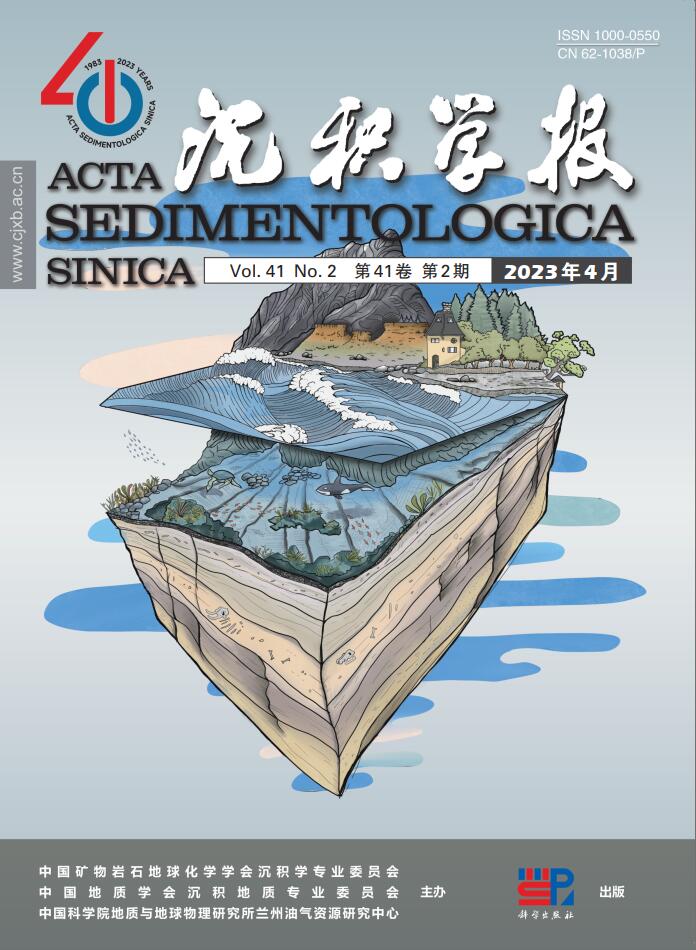











 DownLoad:
DownLoad:
